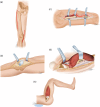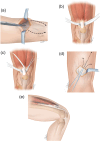Old but gold: Is the Judet procedure still a viable option for posttraumatic knee stiffness in 2024? A comprehensive systematic review and meta-analysis
- PMID: 39512905
- PMCID: PMC11540935
- DOI: 10.1002/jeo2.70079
Old but gold: Is the Judet procedure still a viable option for posttraumatic knee stiffness in 2024? A comprehensive systematic review and meta-analysis
Abstract
Background: Posttraumatic extension contracture of the knee (PECK) is common after knee injury. Initial management is conservative to improve the range of motion; if it fails, surgery may be necessary. This systematic review analyses existing literature on Judet quadricepsplasty for PECK. We will assess clinical outcomes, complications, patient satisfaction and factors that may influence its success.
Methods: A search was conducted on 25 November 2023, adhering to preferred reporting items for systematic reviews and meta-analyses guidelines. PubMed, Embase and Google Scholar were used. Search strings were ([Judet] OR [quadricepsplasty]) AND (knee) AND (stiffness) and ([Judet] OR [quadricepsplasty]) AND (knee). Inclusion criteria: English articles focused on PECK, published between 2003 and 2023, and a minimum follow-up of 24 months. Exclusion criteria: case reports, alternative techniques, knee stiffness cases not only due to trauma, a sample size of <10 patients and articles not reporting functional outcomes.
Results: Among selected studies, 239 patients were considered. The average time between injury and Judet was 27 months. The population was predominantly male; the mean follow-up was 33 months. An average intraoperative knee range of motion improvement of 79.1 degrees (confidence interval 76.9; 81.3) compared to the average preoperative starting value of 30.7 degrees was observed. This improvement decreased by 13.5 degrees at the first postoperative check and by an additional 2.4 degrees at the follow-up, while maintaining an average value of bending above 90 degrees.
Conclusion: Judet quadricepsplasty appears an effective technique for the management of PECK. The heterogeneity of included studies and the absence of standardized outcome measures limit the ability to draw definitive conclusions.
Level of evidence: Level III.
Keywords: Judet quadricepsplasty; knee injury; posttraumatic knee extension contracture; range of motion.
© 2024 The Author(s). Journal of Experimental Orthopaedics published by John Wiley & Sons Ltd on behalf of European Society of Sports Traumatology, Knee Surgery and Arthroscopy. Traumatology, Knee Surgery and Arthroscopy.
Conflict of interest statement
The authors declare no conflict of interest.
Figures




Similar articles
-
Effects of Judet Quadricepsplasty in the Treatment of Post-traumatic Extension Contracture of the Knee.Orthop Surg. 2021 Jun;13(4):1284-1289. doi: 10.1111/os.12950. Epub 2021 May 6. Orthop Surg. 2021. PMID: 33955701 Free PMC article.
-
Thompson Versus Judet Techniques for Quadricepsplasty: A Systematic Review and Meta-analysis of Outcomes and Complications.JB JS Open Access. 2024 Jul 30;9(3):e24.00040. doi: 10.2106/JBJS.OA.24.00040. eCollection 2024 Jul-Sep. JB JS Open Access. 2024. PMID: 39081670 Free PMC article. Review.
-
The judet quadricepsplasty for elderly traumatic knee extension contracture: a case report and review of the literature.Biomedicine (Taipei). 2019 Sep;9(3):21. doi: 10.1051/bmdcn/2019090321. Epub 2019 Aug 27. Biomedicine (Taipei). 2019. PMID: 31453802 Free PMC article.
-
Safety and efficacy of the modified Judet quadricepsplasty in patients with post-traumatic knee stiffness.Eur J Orthop Surg Traumatol. 2021 Apr;31(3):549-555. doi: 10.1007/s00590-020-02802-3. Epub 2020 Oct 13. Eur J Orthop Surg Traumatol. 2021. PMID: 33051692
-
The Judet quadricepsplasty for management of severe posttraumatic extension contracture of the knee. A report of a bilateral case and review of the literature.Clin Orthop Relat Res. 1990 Jul;(256):169-73. Clin Orthop Relat Res. 1990. PMID: 2194722 Review.
References
Publication types
LinkOut - more resources
Full Text Sources
Research Materials

